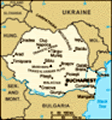COMING SOON HOUSE ADVERTISING ads_leader
If you saw the Seinfeld episode about the "gifts" of the Romanian gymnast, you know what I am saying. But for most of you, all we know about Romania are the famous gymnasts like Nadia, and the Karolyi coaching team. But a good friend of mine, known as "Dirty Pat" is teaching in Bucharest, Romania this year on a Fulbright Scholarship. He has graciously asked me to join him (and his lovely wife) for a few days, on my way to Istanbul.
Romania is located in southeastern Europe, with a population of only 20 million people. Bucharest, at almost 2 million people, is the largest city. Romania is a semi-presidential democracy, with a bicameral parliament. The President is currently Klaus Iohannis. Romania is in the European Union, as well as NATO.
"Romanian legend has it that the city of Bucharest was founded on the banks of the Dambovita River by a shepherd named Bucur, whose name literarily means "joy." His flute playing reportedly dazzled the people and his hearty wine from nearby vineyards endeared him to the local traders, who gave his name to the place.
Old Town Bucharest, or
Lipscani, is named for the many German traders from Lipsca or Leiptzig. Other streets took on the names of various old craft communities and guilds, such as Blanari (furriers), Covaci (blacksmiths), Gabroveni (knife makers) and Cavafii Vechii (shoe-makers). The mix of nationalities and cultures is reflected in the mishmash of architectural styles, from baroque to neoclassical to art nouveau.
Today, the area is home to art galleries, antique shops, coffeehouses, restaurants and night-clubs. While walking in the narrow cobblestone streets one can imagine the long-gone shopkeepers outside near their stores, inviting bypassers to buy their merchandise."
The mighty Danube flows 1788 miles from its origin in the Black Forest of Germany to the Black Sea. Just before reaching the sea, it forms 2200 square miles of rivers, deltas, canals, marshes and islands, creating a naturalist's paradise. It is a UNESCO Natural World Heritage Site. The Danube flows through nine countries, and four capitals, including Vienna, Bratislava, Budapest, and Belgrade.
Geographically, Romania borders the Black Sea on the southeast, Moldova to the east, Serbia to the southwest, Hungary to the west, Bulgaria to the south, and Ukraine to the north. It gained
independence from the Ottoman Empire in 1877. In WW2, it was an ally of Nazi Germany, against the Soviet Union. Post war Soviet occupation, and fraudulent elections kept Romania under Soviet control until the mid 1950s. In 1965, the infamous Ceausescu came into power, through 1989 when he was overthrown and executed.
So, how do tourists view Bucharest upon first glance? Some say Bucharest is a dilapidated, joyless, and overcrowded Communist failure. In its defense, they have survived numerous Turkish invasions, two World Wars, two major earthquakes, and a real despot of a dictator. Maybe they are still rehabilitating? But it could make for a fascinating visit.
Trying to unlock its hidden charms with me is my old pal, Dirty Pat, otherwise known as Edward Patrick McDermott, Esquire, who I met in Nawlins during Super Bowl 47. His Ravens played my Niners, and won! But along the way, we forged a friendship, and have visited them in Annapolis a few years back.
Whether that means museums and palaces, or bars and cafe's, you know what my preferences are. One museum or palace is fine, then it is time to try the local brews. If Bucharest was indeed, the "little Paris" in the early 20th century, it might be challenging to find the hidden charm (often called
city of joy), covered up by years of the Ceausescu regime. And they say a decent base of Italian language would serve a tourist well with the Romanian language. Consider me un-served!
One thing, beware of old currency, as in 2005, Romania knocked off FOUR zeroes from their currency! Some are hanging around, though no longer legal tender. Pickpockets are another real problem, usually in the form of young children. Stray dogs are another ongoing problem, with over a million rounded up since 2005. Another big danger: everyone smokes!! And I hear they are racists!
Totally unrelated: In a 2012 heist, thieves entered the Kunsthal museum in Rotterdam and made off with seven works by masters including Henri Matisse, Claude Monet and Paul Gauguin — as well as <em style="background-color: transparent; box-sizing: border-box; color: font-family: Georgia,serif; font-size: 17px; font-size-adjust: none; font-stretch: 100%!;(MISSING) font-style: italic; font-variant: normal; font-weight: 400; letter-spacing: normal; line-height: 28.99px; orphans: 2; text-align: left; text-decoration: none; text-indent: 0px; text-transform: none; vertical-align: baseline; white-space: normal; word-spacing: 0px; border-width: 0px; border-color: border-style: none; padding: 0px; margin: 0px;">Tête d'Arlequin, a 1971 painting by Picasso. Authorities put the work's value at about $900,000. A painting by Pablo Picasso that was stolen from a Dutch museum six years ago may have resurfaced in Romania, prosecutors say.
During the trial of the art thieves, Dutch newspaper NRC
reported that an analysis of the ashes from Olga's oven showed that at least three or four canvases had been burned there — but that authorities would not be able to be prove definitively that it was the stolen Kunsthal paintings that had been burned.
And the fates of the Picasso and Monets were even more mysterious, because they "were produced on board and paper, which wouldn't leave any traces if burned."
Now, if this is true, shame on them!!!!
You can guess the above photos: the stolen art, Nadia, and Tricky Dick with Ceausescu.
COMING SOON HOUSE ADVERTISING ads_leader_blog_bottom
Tot: 0.106s; Tpl: 0.011s; cc: 13; qc: 27; dbt: 0.0677s; 1; m:domysql w:travelblog (10.17.0.13); sld: 1;
; mem: 1.1mb







